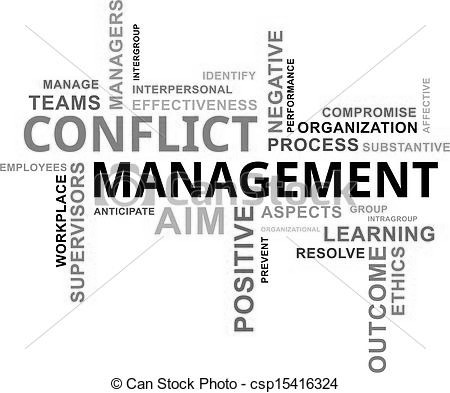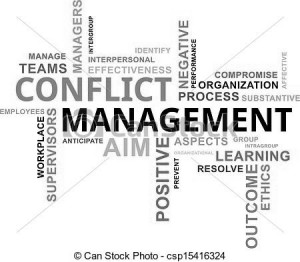Conflict is a process that gets initiated when one party believes or perceives that another party has affected or is likely to affect its well-being. Once a conflict comes into picture, the process of negotiation commences. A negotiation can be successful only when each party shows a willingness to consider the other party’s offers and an inclination to budge from its position so that the conflict gets resolved and a win-win situation is created.
According to the Traditional view of conflict, conflict is perceived as something harmful and destructive and it needs to be avoided. This view highlights the dysfunctional nature of conflict that hinders the functioning of groups and teams and stalls the progress of the organization. But, more recent views on conflict, like Human Relations View or Interactionist View, describe conflict in a better light. These views support the notion of functional conflict that leads to diversity in a group and helps in generation of new ideas and thought processes. The Human Relations View of conflict states that conflict is a natural and inevitable outcome of any process where a group works together. Conflict cannot be entirely eliminated and it may turn out to be beneficial for the group or organization. The Interactionist view goes one step further and states that conflict is a positive force in any group and a minimum level of conflict must be nurtured in a group for a group to succeed. The idea behind this view is that if in a group, everyone tends to think on the same line, the group will soon become static and unresponsive and will suffer from dearth of new ideas. Innovation will be stifled and that would lead to inferior performance of the group.
What gives rise to a conflict? Various sources of conflict can be summarized as:
- Task Conflict (Minor source) – conflicts over content and goals of work
- Relationship Conflict (Major source) – conflicts based on un-mapped relationships
- Process Conflict (Minor source) – conflict over how a process gets carried out
The conflict process consists of 5 stages, namely:
- Potential opposition or incompatibility
- Cognition and personalization
- Intentions,
- Behaviour
- Outcomes
Conflicting categories of people can primarily be categorized as:
- Competitors – define people whose primary motive is to outperform others.
- Individualists – people who care about maximizing their own gains only.
- Cooperators – people concerned about maximizing joint or group outcomes.
- Equalizers – people interested in minimizing the differences between themselves and others.
Each level of conflict and each category of people in conflict have its own characteristics and ways to manage or handle the conflict.
Now, what happens when a conflict is left unresolved? It escalates through various levels and as it passes through the levels it gets more aggravated and unmanageable. The escalation phases are:
Latent tensions -> overt conflicts -> power struggle ->destructive violence.
In latent tensions, tensions between parties have started brewing but they still have not surfaced. This phase is the best time to manage the situation and stop the tension from turning into a conflict. Next stage comes when the tensions have not been dissolved and they have taken the shape of overt conflicts. If overt conflicts are not resolved, it leads to power struggle where each party tries to dominate over the other and to ensure that its interests are taken care of as opposed to the rival party’s interests. From a phase of hidden skepticism and lack of trust, we have now reached to a stage of open hostility. Soon, people will start resorting to destructively violent means to achieve their ends. To ensure that such a thing never happens, it is of pivotal importance to manage dysfunctional conflict as soon as it tries to originate.
There are various kinds of conflict handling or negotiation mechanisms which could be understood by in terms of extent of cooperativeness and extent of assertiveness shown by the conflicting parties. In order to resolve a conflict successfully, one needs to be cooperative enough to understand the other party’s point of views and offers, as well as assertive enough to justify one’s own point and to prevent the other party from taking undue advantage of him.
The various mechanisms are:
- Competing – The conflicting party shows lack of cooperation and high assertiveness and tries to make the other party accept its demands, without paying heed to the latter’s requirements.
- Avoiding– Conflicting party shows lack of cooperation as well as assertion – tries to flee from the situation leaving it unresolved.
- Compromising– Party is partly cooperative and partly assertive and tries to reach at a compromise.
- Accommodating– Conflicting party is highly cooperative and non assertive and shows the inclination to give in to the opposition’s demands at the cost of its own interests.
- Collaborating– Conflicting party is highly cooperative and highly assertive and tries to resolve the conflict in a mutually beneficial way.
BATNA theory (Best Alternative to a Negotiated Agreement) says that each party has a preferred point and a resistance point which stretches beyond the preferred point. Preferred point of a party denotes the negotiation that leaves the party completely satisfied. The resistance point is the best alternative to that perfect negotiation. The settlement range is an area of overlapping of the two parties’ aspiration ranges. Parties show willingness to go beyond their preferred points in case current negotiations fail and no agreement can be reached, but are not ready to accept a solution that is worse than its BATNA, i.e., best alternative.
To conclude, we can summarize that a negotiation is only successful when both parties are willing to cooperate to resolve a certain issue that affects them both. Negotiation can be defined as a process were two parties start crossing a bridge from two sides at the same time so that the differences between them can be bridged based on mutual interest and consensus.





6 Comments. Leave new
Excellent work!
Good article. Conflict occurs due to lack of communication and misunderstanding.
Amazingly written..
Well elaborated.. Simple explanation..
Commendable work
impressive